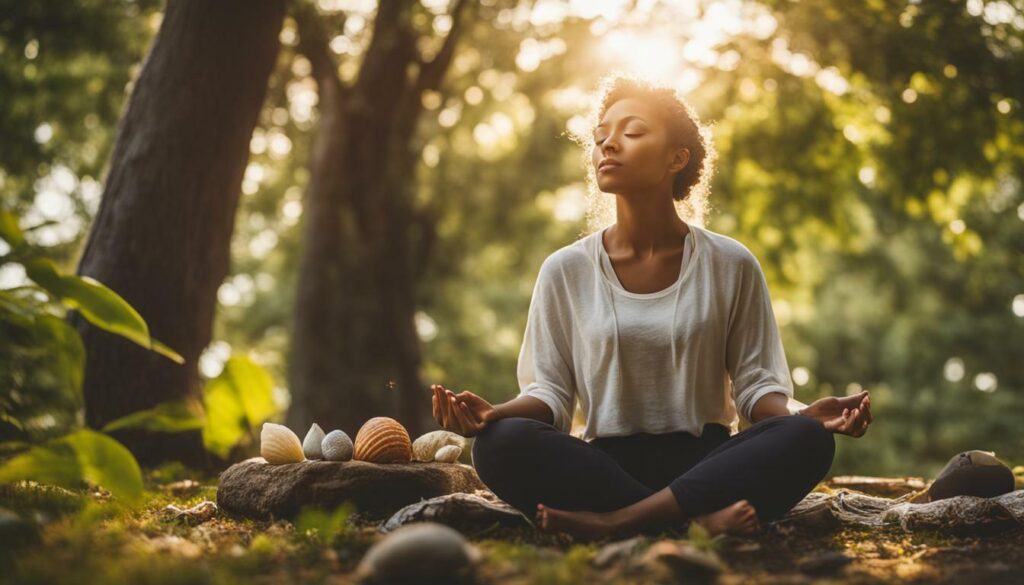Are you ready to unlock the power of your mind through the practice of mindfulness techniques? In this article, we will delve into the world of mindfulness techniques and how they can help you master your mind. Discover the benefits of mindfulness and learn simple and structured exercises to incorporate into your daily life.
Key Takeaways:
- Mindfulness techniques can reduce stress, anxiety, and symptoms of depression.
- Mindfulness involves being fully present and aware of sensations and feelings without judgment.
- Simple mindfulness exercises include paying attention to your environment, living in the moment, accepting yourself, and focusing on your breath.
- More structured exercises include body scan meditation, sitting meditation, and walking meditation.
- Mindfulness can be practiced anywhere and anytime, and consistent daily practice is recommended for about six months.
Understanding the Benefits of Mindfulness
The practice of mindfulness techniques offers a wide range of benefits, both physical and mental. Incorporating mindfulness into your daily routine can lead to reduced stress, anxiety, and symptoms of depression. Research has shown that mindfulness exercises, such as meditation and breathing exercises, can calm the mind, improve focus, and enhance overall well-being.
One of the key benefits of mindfulness is its ability to reduce stress. When we practice mindfulness, we are better able to observe our thoughts and emotions without judgment, allowing us to approach challenging situations with a sense of calm and clarity. Regular mindfulness practice has also been shown to lower levels of stress hormones, such as cortisol, in the body.
Mindfulness techniques can also have a positive impact on mental health. Studies have found that mindfulness-based interventions can significantly reduce symptoms of anxiety and depression. By training our minds to be present and aware, we can better manage negative thoughts and emotions, leading to improved mental well-being.
In addition to its mental health benefits, mindfulness can also improve physical health. Research has shown that mindfulness practices can lower blood pressure, reduce chronic pain, and improve sleep quality. By practicing mindfulness, we can cultivate a greater sense of body awareness and make healthier choices that support our overall well-being.

| Benefits of Mindfulness | Physical | Mental |
|---|---|---|
| Reduced stress | Lower blood pressure | Reduced symptoms of anxiety and depression |
| Improved focus | Reduced chronic pain | Enhanced well-being |
| Enhanced body awareness | Better sleep quality |
“Mindfulness is the awareness that arises from paying attention, on purpose, in the present moment, non-judgmentally.” – Jon Kabat-Zinn
By embracing mindfulness techniques, we can unlock our full potential and live a more fulfilling life. Whether you are a beginner or have been practicing mindfulness for years, there are countless exercises and strategies available to suit your needs. Stay tuned for the following sections where we will delve deeper into specific mindfulness techniques and how to incorporate them into your daily life.
Stay tuned for the following sections:
- What Is Mindfulness?
- Simple Mindfulness Techniques for Beginners
- Embracing Mindfulness in Daily Life
What Is Mindfulness?
Mindfulness is about being fully present in the current moment, without judgment or attachment. It involves paying attention to your thoughts, feelings, and sensations with open curiosity and acceptance. By cultivating mindfulness, you can develop a deeper sense of self-awareness and enhance your overall well-being.
One way to practice mindfulness is through simple exercises that can be incorporated into your daily life. For example, you can start by paying attention to your environment, noticing the sights, sounds, and smells around you. This helps to anchor your awareness in the present moment and can be done anywhere, whether you’re walking outside or sitting at your desk.
Another technique is to focus on your breath. Taking slow, deep breaths and observing the sensation of each inhale and exhale can help calm your mind and bring you into the present moment. By directing your attention to your breath, you can temporarily let go of worries and distractions, allowing yourself to fully experience the here and now.
For those seeking a more structured approach, there are also specific mindfulness exercises such as body scan meditation, sitting meditation, and walking meditation. These practices involve bringing your attention to different parts of your body, observing the sensations, and cultivating a non-judgmental awareness. They can help promote relaxation, reduce stress and anxiety, and increase body awareness.
Table: Examples of Mindfulness Techniques
| Technique | Description |
|---|---|
| Environment Awareness | Pay attention to the sights, sounds, and smells around you. |
| Focused Breathing | Direct your attention to your breath, observing each inhale and exhale. |
| Body Scan Meditation | Bring your attention to different parts of your body, observing sensations without judgment. |
| Sitting Meditation | Practice stillness and focus by sitting in a comfortable position and directing your attention to your breath or a specific object. |
| Walking Meditation | Engage in mindful walking, paying attention to the physical sensations and movements involved. |
Blockquote: Quote on the Transformative Power of Mindfulness
“Mindfulness is not just a buzzword; it is a powerful tool for personal growth and well-being. By simply observing your thoughts and emotions without judgment, you can transform your relationship with yourself and the world around you. It is a practice that anyone can learn, and with consistent effort, it has the potential to create positive change in all aspects of your life.”

With its numerous benefits and potential for personal growth, mindfulness techniques are worth exploring for anyone seeking to master their mind and improve their overall well-being. Whether you choose to start with simple exercises or dive deeper into structured practices, incorporating mindfulness into your daily life can have a transformative impact. So take a moment, breathe, and begin your mindfulness journey today.
Simple Mindfulness Techniques for Beginners
If you’re new to mindfulness, these simple techniques will help you get started on your path to self-awareness. Mindfulness is the practice of being fully present in the moment, with a non-judgmental attitude towards your thoughts and sensations. By incorporating these techniques into your daily routine, you can begin to experience the benefits of mindfulness.
1. Pay attention to your environment: Take a few moments each day to fully engage your senses. Notice the sounds, smells, and sights around you. This simple act of observation can help bring your focus to the present moment.
2. Live in the moment: Often, our minds are preoccupied with thoughts of the past or worries about the future. Practice redirecting your attention to the present moment. Engage in activities with full presence, such as savoring a meal, going for a walk, or spending time with loved ones.
3. Accept yourself: Cultivate self-acceptance by acknowledging and embracing your thoughts and emotions without judgment. Allow yourself to feel whatever arises, knowing that it is a natural part of the human experience.
| Mindfulness Techniques for Beginners | Description |
|---|---|
| Paying attention to your environment | Engage your senses and observe the world around you |
| Living in the moment | Redirect your attention to the present moment |
| Accepting yourself | Embrace your thoughts and emotions without judgment |
Remember, mindfulness is a skill that can be developed over time. Be patient with yourself as you embark on this journey of self-discovery. With consistent practice, you can cultivate a greater sense of calm, clarity, and self-awareness in your life.

“I never thought that simply paying attention to my surroundings could have such a profound impact on my well-being. Mindfulness has helped me find joy in the small moments and reduce stress in my daily life.” – Sarah M.
“Accepting myself without judgment has been a game-changer. Mindfulness has taught me to embrace all parts of myself, even the ones I used to struggle with. It’s an ongoing practice, but it’s worth it.” – David R.
Embracing Mindfulness in Daily Life
Mindfulness is not just reserved for quiet meditation; it can be seamlessly integrated into your daily life. By practicing mindfulness techniques throughout the day, you can cultivate a sense of presence, reduce stress, and improve your overall well-being. Here are some simple strategies to help you embrace mindfulness in your everyday activities:
- Mindful Interactions: Whether you’re having a conversation with a friend or coworker, practice being fully present and attentive. Listen actively, without judgment or distraction, allowing the conversation to unfold naturally.
- Mindful Work: Bring mindfulness to your work by taking short breaks throughout the day to focus on your breath or do a quick body scan. This can help you regain focus, reduce stress, and enhance productivity.
- Mindful Leisure Time: Engage in activities that bring you joy and relaxation, such as reading, gardening, or cooking. Practice being fully present in these moments, savoring the experience and letting go of external distractions.
Table: Mindful Activities
| Activity | Description |
|---|---|
| Mindful Eating | Eat slowly, savoring each bite and paying attention to the taste, texture, and aroma of your food. |
| Mindful Walking | Take a walk outdoors and focus on the sensations in your body as you move. Observe the sights, sounds, and smells around you. |
| Mindful Breathing | Take a few moments throughout the day to focus on your breath. Notice the sensation of the breath entering and leaving your body. |
Remember, mindfulness is a skill that takes practice and patience. Start small by incorporating mindfulness into one aspect of your daily life and gradually expand from there. With consistent effort, you can make mindfulness a natural and effortless part of your routine, reaping the benefits of improved well-being and inner peace.

Body scan meditation is a powerful mindfulness technique that involves systematically scanning your body for sensations and tension. It allows you to bring attention to each part of your body, cultivating a deep sense of self-awareness and relaxation. This practice is particularly beneficial for those seeking to reduce stress, anxiety, and physical discomfort.
Begin by finding a comfortable position, either sitting or lying down. Close your eyes and take a few deep breaths, allowing yourself to settle into the present moment. Start by directing your focus to your feet, noticing any sensations or tension in this area. Slowly work your way up through your legs, hips, abdomen, chest, back, arms, and finally to your head.
As you scan each part of your body, try to observe without judgment. If you notice any discomfort or tension, simply acknowledge it without trying to change or fix it. Allow yourself to be fully present with whatever sensations arise, accepting them as they are. With each breath, imagine releasing any tension or tightness, allowing your body to relax more deeply.
Regular practice of body scan meditation can help you develop a greater awareness of your body and its signals. It can also promote a sense of calm and overall well-being. Incorporate this technique into your mindfulness routine and experience the transformative power it can have on your mind and body.

| Benefits of Body Scan Meditation |
|---|
| Reduces stress and anxiety |
| Promotes relaxation and a sense of calm |
| Increases body awareness |
| Enhances self-awareness and mindfulness |
“The body scan meditation has been a game-changer for me. It helps me release tension and connect more deeply with my body. I highly recommend incorporating it into your mindfulness practice.” – Sarah
Tips for Effective Body Scan Meditation
- Find a quiet and comfortable space where you can relax without interruptions.
- Use guided body scan meditations or meditation apps to assist you in the beginning.
- Start with shorter sessions, gradually increasing the duration as you become more comfortable.
- Be patient and kind to yourself. It’s okay to have wandering thoughts; simply guide your attention back to the body.
- Practice regularly, ideally daily, to experience the full benefits of body scan meditation.
By incorporating body scan meditation into your mindfulness practice, you can deepen your connection with your body, reduce stress, and enhance your overall well-being. Take a few moments each day to explore this transformative technique and embrace the power of being fully present in the moment.
Sitting Meditation: Cultivating Stillness and Mindfulness
Sitting meditation is a cornerstone of mindfulness practice, allowing you to observe your thoughts and emotions from a place of stillness. By carving out a dedicated space and time for sitting meditation, you create an opportunity to cultivate inner calm and self-awareness. Here’s how you can begin:
Step 1: Find a Comfortable Position
Start by finding a comfortable seated position that allows you to be both relaxed and alert. You can sit on a cushion or chair, ensuring that your back is straight but not rigid. Place your hands on your lap or rest them gently on your thighs. Close your eyes or soften your gaze, whatever feels most natural to you.
Step 2: Focus on Your Breath
Bring your attention to your breath as it flows in and out of your body. Notice the sensation of the breath entering and leaving through your nostrils or the rise and fall of your abdomen. Be fully present with each breath, allowing it to anchor you in the present moment.
Step 3: Observe Your Thoughts
As you sit in stillness, thoughts will naturally arise. Instead of getting caught up in these thoughts, simply observe them without judgment. Imagine them as passing clouds in the sky, coming and going without holding onto them. Whenever you find your mind wandering, gently bring your attention back to your breath.
| BENEFITS OF SITTING MEDITATION |
|---|
| “Sitting meditation is a powerful practice that can improve focus, reduce stress, and promote emotional well-being.” |
| Mindfulness |
| Increased self-awareness |
| Improved concentration |
| Reduced anxiety and stress |
| Enhanced emotional resilience |
“Sitting meditation is the gateway to inner peace and self-discovery.” – Jon Kabat-Zinn
Regular practice of sitting meditation can have profound effects on your overall well-being. It enhances your ability to stay present, reduces stress and anxiety, and cultivates a deeper sense of self-awareness. As you become more comfortable with this practice, you may choose to extend the duration of your meditation sessions.
Remember, mindfulness is a skill that can be developed with consistent practice. Start with just a few minutes each day and gradually increase the duration over time. With patience and dedication, sitting meditation can help you cultivate stillness, focus, and a greater sense of connection with yourself and the world around you.

Walking meditation offers a unique opportunity to bring mindfulness into your movements and fully experience the present moment. It is a practice that involves paying attention to each step, observing the sensations in your body, and being fully present in the act of walking.
During walking meditation, you can focus on the sensation of your feet touching the ground, the movement of your legs, and the rhythm of your breath. By bringing your attention to these physical sensations, you can cultivate a sense of calm and grounding. This practice can be especially beneficial for those who find it challenging to sit still during traditional meditation.
One simple way to practice walking meditation is to find a quiet and peaceful place outdoors, such as a park or a garden. Begin by standing still and taking a few deep breaths, allowing yourself to arrive in the present moment. Then, start walking slowly and deliberately, paying attention to each step.
You can count your steps silently in your mind, focusing on the sensation of lifting your foot, moving it forward, and placing it back down on the ground.
As you continue walking, you might notice the sensations in your body, such as the contact between your feet and the ground or the movement of your arms. Allow these sensations to be your anchor, bringing your attention back to the present moment whenever your mind starts to wander.
Remember that the goal is not to reach a specific destination but to fully immerse yourself in the experience of walking.

Walking meditation offers numerous benefits for both the body and the mind. By combining movement with mindfulness, it can help reduce stress, increase mental clarity, and improve overall well-being. Here are some of the key benefits of practicing walking meditation:
- Physical Exercise: Walking is a gentle form of exercise that can improve cardiovascular health, strengthen muscles, and boost energy levels.
- Stress Reduction: Engaging in mindful walking can help reduce stress and anxiety by providing a peaceful and meditative experience.
- Mental Clarity: Walking meditation can clear the mind and enhance mental focus, allowing for greater clarity and insight.
- Connection with Nature: Walking outdoors in nature can enhance feelings of connection and appreciation for the natural world, promoting a sense of well-being.
- Improved Mood: Engaging in walking meditation releases endorphins, which are known as “feel-good” hormones, leading to an improved mood and increased happiness.
As you can see, walking meditation is a powerful practice that combines movement and mindfulness to foster a deeper connection with yourself and the world around you. Whether you’re just starting or have been practicing mindfulness for some time, walking meditation can be a valuable addition to your routine.
| Practical Tips for Walking Meditation |
|---|
| 1. Find a quiet and peaceful location where you can walk without distractions. |
| 2. Start with a few deep breaths to center yourself before you begin walking. |
| 3. Walk slowly and deliberately, paying attention to each step and the physical sensations in your body. |
| 4. If your mind starts to wander, gently bring your attention back to the present moment and the act of walking. |
| 5. Practice walking meditation for a duration that feels comfortable for you, whether it’s a few minutes or longer. |
| 6. Gradually increase the duration of your walking meditation sessions as you become more comfortable with the practice. |
Practicing Mindfulness Anywhere, Anytime
Mindfulness doesn’t have to be confined to a specific time or place; it can be practiced anytime and anywhere. Whether you’re sitting at your desk, waiting in line, or taking a walk in nature, you can incorporate mindfulness exercises into your daily routine. These simple techniques can help you bring your attention to the present moment, reduce stress, and cultivate a sense of inner peace.
One of the easiest ways to practice mindfulness is by paying attention to your environment. Take a moment to notice the sights, sounds, and sensations around you. Whether it’s the chirping of birds, the feeling of the sun on your skin, or the vibrant colors of the flowers, allow yourself to fully experience the present moment without judgment.
Living in the moment is another key aspect of mindfulness. Instead of dwelling on the past or worrying about the future, focus on what is happening right now. Engage all your senses and immerse yourself in the present experience. By doing so, you can reduce anxiety and find greater contentment in your daily life.
Breath-focused exercises are also an effective way to practice mindfulness. Take a few minutes each day to sit in a comfortable position and bring your attention to your breath.
Notice the sensation of the breath entering and leaving your body. If your mind wanders, gently guide it back to the breath. This simple practice can help calm your mind, anchor you in the present moment, and increase your overall sense of well-being.

Remember, mindfulness is a skill that can be developed with regular practice. Start by dedicating a few minutes each day to these exercises and gradually increase the duration over time. Aim for consistency rather than intensity. The more you integrate mindfulness into your daily life, the more benefits you will experience.
| Mindfulness Exercises | Benefits |
|---|---|
| Paying attention to your environment | Increased present moment awareness |
| Living in the moment | Reduced anxiety and improved contentment |
| Focus on your breath | Calming the mind and promoting overall well-being |
“Mindfulness is the key to unlocking the full potential of your mind and finding peace in the midst of chaos.” – Unknown
Making Mindfulness a Habit: The Power of Consistency
Consistency is key when it comes to mindfulness practice, and making it a habit can have a profound impact on your overall well-being. Just like any other skill, mindfulness requires regular practice to develop and deepen. By incorporating mindfulness exercises into your daily routine, you can train your mind to be more present, focused, and aware.
One effective way to make mindfulness a habit is by setting aside dedicated time each day for practice. Start with just a few minutes and gradually increase the duration as you become more comfortable. You can choose to practice mindfulness in the morning, during your lunch break, or before bed – whatever works best for you.
Creating a peaceful and inviting environment can also enhance your mindfulness practice. Find a quiet space where you can minimize distractions and make yourself comfortable. You might consider using props like cushions, blankets, or a meditation bench to support your posture and make your practice more enjoyable.
The Road to Mindfulness Mastery
It’s important to approach mindfulness with an open and non-judgmental attitude. Don’t get discouraged if your mind wanders during meditation or if you find it challenging to stay present. Remember, mindfulness is a skill that takes time to develop, and every moment of practice counts towards your progress.
To help you stay motivated and consistent, try different mindfulness exercises and techniques. Variety can keep your practice fresh and prevent boredom. You can explore guided meditations, mindfulness apps, or join a local mindfulness group for support and inspiration. Ultimately, finding what resonates with you is key to making mindfulness a lifelong habit.

| Benefits of Consistent Mindfulness Practice | How to Make Mindfulness a Habit |
|---|---|
| Reduces stress, anxiety, and symptoms of depression | Set aside dedicated time each day |
| Improves focus, concentration, and productivity | Create a peaceful and inviting environment |
| Enhances self-awareness and emotional intelligence | Approach mindfulness with an open, non-judgmental attitude |
| Promotes better sleep and overall well-being | Try different mindfulness exercises and techniques |
| Strengthens resilience and coping mechanisms | Find what resonates with you for long-term commitment |
By making mindfulness a habit, you can unlock the transformative power of this ancient practice. Start small, stay consistent, and be patient with yourself along the way. As you cultivate mindfulness in your daily life, you’ll experience greater peace, clarity, and joy.
Mindfulness Techniques for Anxiety and Stress Relief
Mindfulness techniques are powerful tools for managing anxiety and stress, providing a sense of calm and clarity amidst the chaos. By incorporating mindfulness into your daily routine, you can learn to navigate challenging emotions and cultivate a greater sense of peace and well-being. Here are some effective mindfulness techniques to help alleviate anxiety and stress:
Mindful Breathing
One of the simplest and most accessible mindfulness techniques is mindful breathing. Take a moment to focus your attention on your breath, allowing yourself to fully experience each inhale and exhale.
Notice the sensations as the air enters and leaves your body. By bringing your awareness to the present moment through your breath, you can ground yourself and find relief from anxious thoughts.
Body Scan Meditation
Another powerful technique for anxiety and stress relief is body scan meditation. Find a comfortable position and slowly scan your body from head to toe, paying attention to any physical sensations or areas of tension. As you bring awareness to each part of your body, consciously relax and release any tension you may be holding. This practice can help you reconnect with your body and promote a deep sense of relaxation.
Acceptance and Self-Compassion
Practicing acceptance and self-compassion is essential for managing anxiety and stress. Rather than resisting or judging your thoughts and emotions, try to approach them with an attitude of acceptance and non-judgment.
Remember that it’s natural to experience stress and anxiety, and be kind to yourself in these moments. Treat yourself with the same kindness and understanding you would offer to a dear friend in need.

These mindfulness techniques can provide immediate relief from anxiety and stress. Through consistent practice, you can develop a greater sense of self-awareness and resilience, allowing you to navigate life’s challenges with greater ease.
Remember, mindfulness is a skill that can be cultivated by anyone, and it has the potential to transform your relationship with stress and anxiety.
Discover the power of mindfulness and embark on a journey of self-discovery and well-being.
Conclusion
Embrace the power of mindfulness techniques and experience the positive impact they can have on your mind, body, and spirit. Mastering your mind through mindfulness can lead to a significant reduction in stress, anxiety, and symptoms of depression.
By being fully present and aware of sensations and feelings without judgment, you can cultivate a deeper sense of self-awareness and inner peace.
Simple mindfulness exercises, such as paying attention to your environment, living in the moment, accepting yourself, and focusing on your breath, can easily be incorporated into your daily life.
These exercises serve as a foundation for more structured practices like body scan meditation, sitting meditation, and walking meditation. With regular practice, mindfulness can become a habit that enhances your overall well-being.
Mindfulness is not restricted to a specific time or place. It can be practiced anywhere and at any time, making it accessible to everyone. Whether you are at home, work, or anywhere in between, you can bring yourself into the present moment and experience the benefits of mindfulness. Aim for daily practice for at least six months to truly reap the rewards.
Learning mindfulness techniques is an opportunity for personal growth and transformation. It is a skill that can be learned by anyone, regardless of age or background. As mindfulness continues to gain recognition, it has the potential to become a transformative social phenomenon, positively impacting individuals and communities alike.
FAQ
What are mindfulness techniques?
Mindfulness techniques involve being fully present and aware of sensations and feelings without judgment.
What are the benefits of mindfulness?
Mindfulness techniques can reduce stress, anxiety, and symptoms of depression, improve focus and overall well-being.
How can I practice mindfulness?
You can practice mindfulness by paying attention to your environment, living in the moment, accepting yourself, and focusing on your breath.
What are some simple mindfulness exercises for beginners?
Simple mindfulness exercises include paying attention to your environment, living in the moment, accepting yourself, and focusing on your breath.
What are some more structured mindfulness exercises?
More structured mindfulness exercises include body scan meditation, sitting meditation, and walking meditation.
Can mindfulness be practiced anywhere and anytime?
Yes, mindfulness can be practiced anywhere and anytime.
How often should I practice mindfulness?
It is recommended to aim for daily practice for about six months.
Can anyone learn mindfulness?
Yes, mindfulness can be learned by anyone.
What are the potential effects of mindfulness becoming a social phenomenon?
Mindfulness has the potential to be a transformative social phenomenon.









